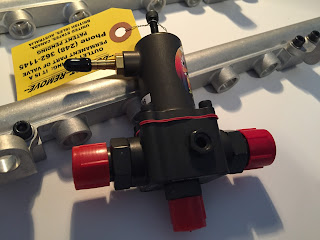First crank, fired up pretty quick.
It's very hard to get these motors to burp the air out of the cooling system on the stand. I have not (yet) tapped bleed fittings in the coolant outlet pipes on this engine. I have however already blocked off the coolant passage in the plenum. Passenger side had good water circulation, but the driver's side did not. Coolant pipe would not get hot enough to indicate water flowing out from that side. After this first start, I disconnected the 90-degree elbow from the drivers side and forced air into the system, blowing into the coolant crossover tube until hot water finally came out from the driver's outlet pipe.
You might also see smoke from the exhaust on the driver's (left) side. When I pressurized the system, I forgot to install the cam sensor, and the resulting oil leak poured down on the exhaust header. Doh! Will take some time and heat cycles to burn off all the oil residue.
Here's another video I took later in the day,
After it all cooled down, I performed a cranking compression check, and cylinder leakdown test. The cranking compression for all cylinders was remarkably consistent, just over 240 psi-- a good jump over Build1. Leakdown rates were even more impressive. All cylinders were less than 2%, despite not yet getting any load on the rings to seat them in properly. There was much worse and scattered leakage values on the old build. All over the map, 6% to 18%. I am going to give credit to Ross pistons, Total Seal rings, and the machine shop for nailing the cylinder finish.
Oil pressure was ~60psi at idle, and the wideband indicated we were a little lean, but that might be a function of the cam overlap at idle. Once I opened the throttle and brought the revs up, it richened up. Alternator isn't charging, so I need to figure that out, but otherwise I'd call it a successful day. Now off to the dyno!






